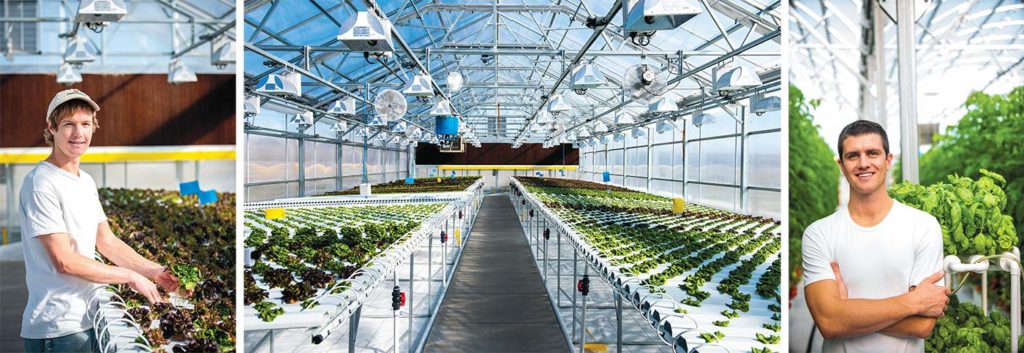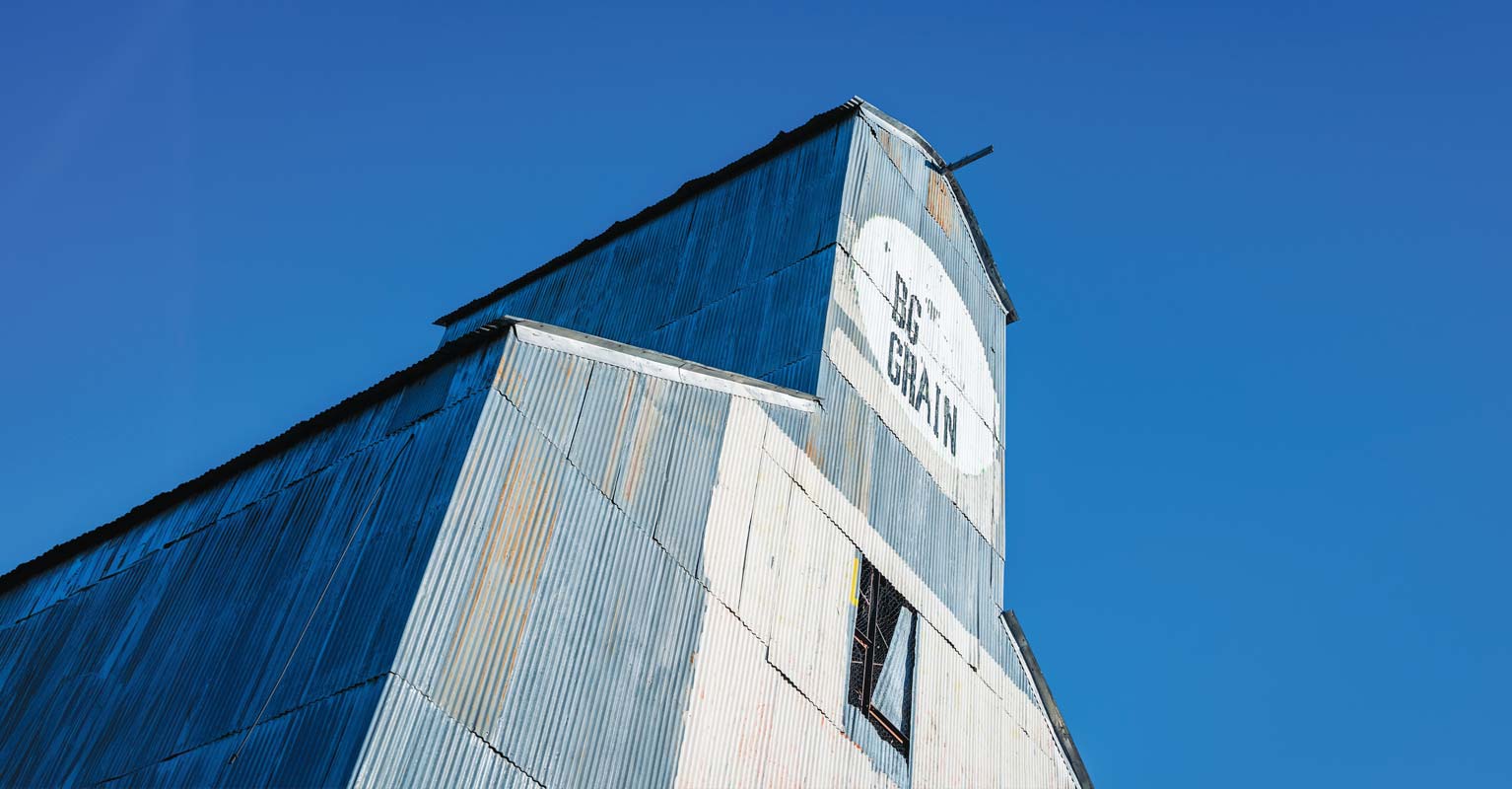A local hydroponics farm offers fresh, beautiful vegetables all year long
Beneath a crisp bluebird sky, with inches of snow accumulating against the walls of a crystalline greenhouse, 1,487 tomato plants lapped nutrient-rich water from a hose. The air was spicy, full of that potent aroma ubiquitous with tomatoes, as the plants’ hearty leaves wiggled in the gentle breeze of the overhead fan. Bumblebees cruised the greenhouse rows despite freezing temperatures outside, and with their periodic pauses—stopping briefly to dip their heads into the plants’ golden flowers—they propagated what would, in ten weeks, become voluminous red slicing tomatoes.
“When you’re able to give a plant exactly what it wants, an amazing thing happens: it produces the perfect fruit,” said Bennett Cawthon, the CEO and co-founder of Bozeman’s Streamline Farms.
Cawthon was as vibrant as the glowing fruit ripening on the vine. With a broad smile and blazing eyes, he pointed to each variable in the greenhouse—from the vents and fans to the bees and string trestles. Pride resonated in his voice as he described the role of each item in his tomato environment.
Cawthon and business partner Brad Schuler launched Streamline Farms in January 2018 with the hopes of providing a sustainable, fresh alternative for local vegetables. Through precise, controlled-environment agriculture, their produce is always in season. The trick, they say, lies in their methods.
Finding Starts
Streamline Farms relies on hydroponics, a method of growing plants without soil. With this system, carefully monitored mineral nutrient solutions are delivered directly to the plant roots and can be adjusted to meet each varietal’s every need.
Cawthon and Schuler are able to produce about 1,400 to 2,200 pounds of tomatoes every week, all within a 6,000-square-foot greenhouse located north of Bozeman. The tomato plants produce for eleven months, and in January the farmers start over with new plant starts that come from a hydroponic grower in Canada. The farmers also grow approximately 16,000 lettuce plants at any given time in their 3,000-square-foot lettuce house in Three Forks.
Turning toward a large tank with hoses protruding from its side, Cawthon explained the tomato system, which doses water from the well with potassium nitrate, calcium nitrate, nitrogen, and phosphorus. At specific times throughout the day, the water is then delivered through drip irrigation to the tomato plants, which grow in bags of peat moss and coconut. This system reduces the risk of root rot or degradation over time and vastly improves produce uniformity.
He used the term “perfect produce,” referencing the cosmetic standards of supermarkets that require produce to be of similar size, free of blemishes, and symmetrical— something that can be difficult to attain in outdoor settings and which contributes to the billions of pounds of produce that goes to waste in the U.S. each year. By controlling the airflow, humidity, and temperature, Streamline Farms is able to consistently grow visually appealing produce.
“You’re not really leaving anything up to crossing your fingers and hoping conditions stay right,” Cawthon said. Schuler, Streamline’s lead farmer and the visionary for the growing model, fell into hydroponics out of a desire to approach farming from a new angle. Originally from Baltimore, Maryland, he graduated from Montana State University in 2015 with a degree in sustainable foods and bioenergy systems.
With experience working at an organic vegetable farm in the Gallatin Valley, he saw how environmental variables made farming unpredictable and wanted to find a different way. “In hindsight, I’m happy I ended up choosing this path,” he said.
While growing plants in an indoor setting reduces the risk from unexpected weather, Schuler said there are other challenges that outdoor farmers don’t face. Without soil, the plants depend on Schuler and Cawthon for everything. “In this kind of farming you have to be very diligent and two steps ahead of what you think is going to happen,” Schuler said.
Cawthon, who spent his childhood in Billings and Santa Barbara, California, graduated from MSU’s Jake Jabs College of Business and Entrepreneurship in 2017 and rounds out the Streamline company with his specific interest in facilities management. As a passionate home cook, Cawthon wants to see more access to fresh ingredients in Bozeman.
“We can’t have high-quality restaurants or high-quality food without high-quality ingredients,” he said.

Cultivating a Vision
As the tomato plants grow, Cawthon, Schuler, and their team of three full-time employees monitor productivity and needs. An on-staff entomologist checks for pests and manages outbreaks with predatory wasps, mites, and ladybugs, while other staffers prune and harvest.
Tomato blossoms are clipped as the plants grow, creating a week-to-week stratigraphy of fruit, with the ripest coming to fruition at the bottom of the plant. During summer months, they grow a foot per week and are routinely trained along the length of the greenhouse. At the end of their eleven-month cycle, the tomato vines reach lengths of seventy feet or more.
While Cawthon lives at the tomato farm and Schuler lives in Three Forks, the Streamline team takes turns checking the greenhouses every day in case of any mechanical failure. A large control panel keeps track of average temperature and humidity and also gives those figures in real time.
“With hydroponics, it’s either working or it’s not,” Cawthon said. The team changes out mechanical parts at the first sign of wear, and the executives sleep with alarms on at night in case of a power loss.
Getting to the point they are at today—where Streamline supplies half a dozen Bozeman grocery stores and a dozen restaurants—required what Cawthon describes as “researching hydroponics to death.”
They’ve toured farms across the country, attended the Indoor Ag-Con in Las Vegas, and have worked with a number of local sustainable agriculturalists. They know the ideal humidity for pollination—too humid and the pollen coats the bees and hinders flight; too little humidity and the pollen won’t stick to the insects’ hairs. They also know the average amount of solar energy Bozeman receives each month of the year.
It all comes together to keep the greenhouses operating at high efficiency, something Schuler and Cawthon value both for reducing overhead and for overall sustainability. Cawthon has calculated the business’s exact carbon footprint and frequently audits their procedures to find ways of improving sustainability.
“A big part of this to me is our overall impact on the environment and the fight against climate change,” Cawthon said, adding that he wants Streamline to be a carbon-neutral company. “I think it’s pretty attainable.”
As one example, the farm works with Bozeman’s Yes Compost to dispose of the 45,000 pounds of plant matter their tomatoes produce in a year. That plant waste is converted into a natural fertilizer as worms break down the material into compost, which is sold locally.
Beyond the procedural decisions that can lower Streamline’s environmental impact, Schuler and Cawthon say the very system of hydroponics is sustainable. It uses about ten times less land with 90 percent less water than conventional growing methods, ultimately leaving more land to nature and more water to the rivers.
Referencing the compost that is made from their plants, Schuler laughed. “We’re not using soil, we’re producing soil.”
Harvesting Reward
On harvest day—which comes frequently with Streamline’s staggered approach—the farmers’ hands glow green and gold. It’s from the ripe tomatoes, still sparkling with yellow flower pollen the greenhouse walls protect from wind that would otherwise blow it away.
The tomatoes are picked the same day they are delivered to ensure rich, truly vine-ripened flavor. Cawthon makes the delivery rounds, dropping off tomatoes, lettuce, and basil to clients twice a week. Th is compares starkly with the industrial model that sees tomatoes picked in clusters while still green, dosed with a chemical, and ripened artificially in a warehouse or on a truck.
Going forward, the growers hope to expand their offerings by optimizing every spare inch of space in their greenhouses. It’s something they hope will bring their price points down. “In terms of what we can produce, it’s very conducive to these higher land prices because we can really pack it in and not have to take up a lot of room while still meeting demand,” Schuler said.
“Bozeman is growing rapidly,” Cawthon added. “We need to keep creating local food that is pesticide- and chemical-free, but also economically sound and affordable to a wide range of socioeconomic classes.”
Given the array of benefits from growing hydroponic produce, Cawthon did admit some crops just can’t thrive in such a setting, such as root vegetables, grains, and corn. “It’s definitely just a piece of a much larger puzzle,” he said, adding that he sees a farming future that integrates conventional methods with other systems like hydroponics.
Sustainable agriculture is an evolving process, the farmers explained.
“Seeing your product and how it makes other people really happy, or seeing someone at a grocery store grab your bag, gives you confidence to know that you’re on the right path,” Schuler said. “We couldn’t be doing it without the Bozeman community.”




